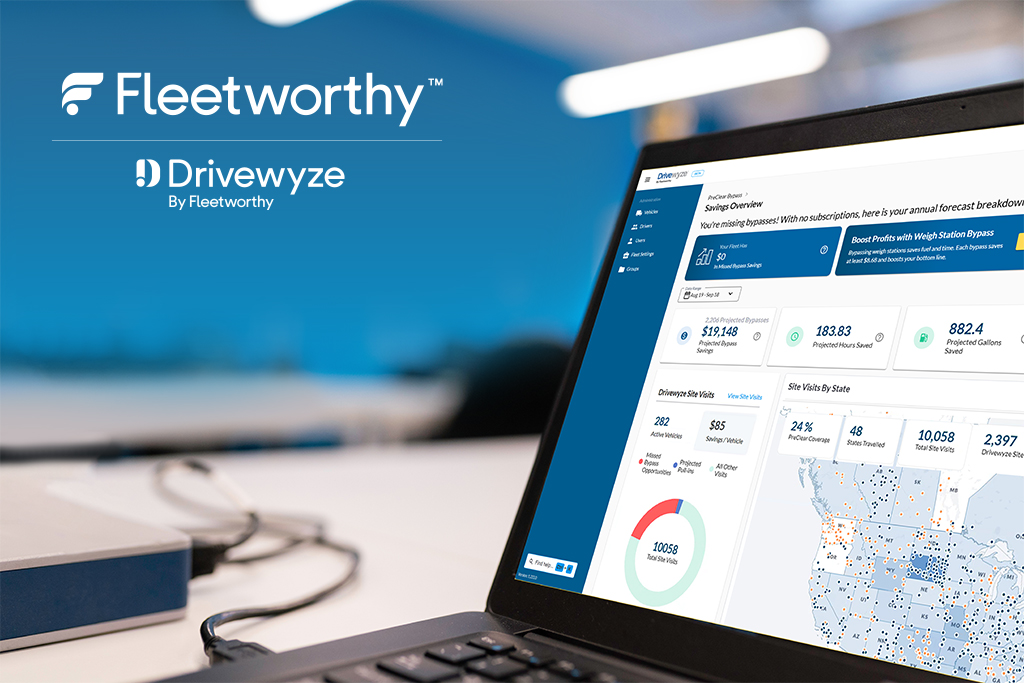For fleet operators, few events carry as much weight as DOT Inspection Week. This annual initiative—spearheaded by the Commercial Vehicle Safety Alliance (CVSA) in coordination with the Federal Motor Carrier Safety Administration (FMCSA)—is a focused, nationwide effort to ensure commercial vehicles and drivers meet rigorous safety and compliance standards. While inspections can occur any day of the year, DOT Inspection Week marks a period of intensified roadside enforcement, with thousands of inspectors across North America conducting a high volume of checks on commercial motor vehicles.
For fleets of all sizes, the stakes are high. A failed inspection can result in immediate out-of-service (OOS) orders, costly fines, CSA score impacts, and even audit triggers. But with proper preparation, DOT Inspection Week becomes less of a risk and more of an opportunity—an opportunity to demonstrate your fleet’s safety culture, reduce liability, and keep vehicles on the road.
This guide walks you through everything you need to know to prepare your fleet for DOT Inspection Week—from understanding what inspectors are looking for to actionable steps that will keep your operations compliant, efficient, and inspection-ready.
Understanding DOT Inspection Week
What is DOT Inspection Week?
DOT Inspection Week, officially known as CVSA’s International Roadcheck, is the largest targeted enforcement program on commercial motor vehicles (CMVs) in North America. During this focused 72-hour initiative, tens of thousands of inspections are conducted on trucks, buses, and their drivers. It’s not just a regulatory checkpoint—it’s a litmus test for how well a fleet is managing safety, compliance, and vehicle maintenance year-round.
The event serves both as an enforcement operation and an educational opportunity. Fleets that perform well can avoid unnecessary downtime, while those that fall short risk costly violations and reputational damage.
Who Conducts It? (CVSA, FMCSA)
The event is organized by the Commercial Vehicle Safety Alliance in partnership with the Federal Motor Carrier Safety Administration, along with Canadian and Mexican transportation authorities. Certified inspectors from state and local agencies participate by performing inspections at weigh stations, roadside checkpoints, and temporary inspection sites.
The CVSA sets the standards and guidelines for inspections, while FMCSA provides federal oversight and enforces safety regulations across the U.S.
Frequency and Timing
DOT Inspection Week typically takes place once per year, usually in May or June, although the specific dates are announced a few months in advance by CVSA. This early notice gives fleets a chance to prepare—but don’t be fooled into thinking you can wait until the last minute. Inspectors increase their activity during this time, and vehicles that are not up to standard will be flagged.
In addition to the main International Roadcheck, CVSA also coordinates other enforcement events like Brake Safety Week and Operation Safe Driver Week, which focus on different aspects of road safety.
Levels of Inspections (Focus on Level I–III)
There are eight levels of inspections, but the most common during DOT Inspection Week are:
- Level I – North American Standard Inspection: The most comprehensive. Covers both driver credentials (e.g., CDL, medical card, HOS logs) and a full vehicle inspection (e.g., brakes, tires, lighting, etc.).
- Level II – Walk-Around Driver/Vehicle Inspection: Similar to Level I, but without checking items that require the inspector to get under the vehicle.
- Level III – Driver/Credential Inspection Only: Focuses exclusively on the driver: CDL, medical certification, logs, seatbelt use, and signs of fatigue or impairment.
Understanding the differences helps you prepare both your vehicles and your drivers for what to expect.
Common Focus Areas
Each year, CVSA highlights special focus areas—specific components or behaviors that will receive increased scrutiny. Historically, these have included:
- Brake systems
- Tires and wheels
- Lighting and reflective devices
- Driver qualifications and credentials
- Hours of Service (HOS) compliance
- Load securement
- Seatbelt use
- Alcohol/drug impairment awareness
Being aware of the current year’s focus allows fleet managers to zero in on potential vulnerabilities before inspections begin.

Key Areas Inspectors Evaluate
To pass a DOT inspection with confidence, fleets must ensure both their vehicles and drivers meet stringent safety, compliance, and documentation standards. Inspectors are trained to spot even minor infractions that could point to deeper operational issues. Here’s a breakdown of the core areas evaluated during DOT Inspection Week:
Vehicle-Related Checks
Inspectors will conduct a physical inspection of the commercial vehicle to identify any mechanical or safety issues. Key systems that are closely examined include:
- Brake Systems: One of the most common out-of-service violations. Inspectors check for brake pad thickness, air leaks, slack adjusters, and ABS indicator lights.
- Tires: Tread depth, sidewall damage, tire inflation, and matching tire sizes on dual wheels are all checked. Worn or mismatched tires are major red flags.
- Lights and Reflectors: All required lights—headlights, brake lights, turn signals, and clearance lights—must be fully functional. Missing or obscured reflectors can result in violations.
- Steering Mechanism and Suspension: Inspectors check for worn steering components, leaking shocks, or issues with ball joints and kingpins that could affect vehicle handling.
- Windshield Wipers, Mirrors, and Horns: While they may seem minor, these components are essential for visibility and safe driving—and inspectors will note deficiencies.
Maintenance Records and DVIR Compliance
In addition to the physical vehicle checks, inspectors may request to see proof that the vehicle is being maintained properly:
- Maintenance Records: Up-to-date records showing repairs, inspections, and regular preventive maintenance are essential. Lack of documentation can signal noncompliance.
- Driver Vehicle Inspection Reports (DVIRs): These must be completed daily and reviewed by drivers. Outstanding defects noted on DVIRs must be addressed and signed off before operation resumes.
Using a digital record system to track these elements helps ensure nothing is missed and documents are easily accessible during inspections.
Driver-Related Checks
Inspectors evaluate whether the driver is fit, qualified, and compliant with federal safety regulations. This includes:
- Commercial Driver’s License (CDL) Validity: The driver must carry a valid CDL with the correct endorsements for the vehicle type. Expired, suspended, or improperly endorsed licenses are major violations.
- Hours of Service (HOS) Logs & ELD Compliance: Inspectors will review electronic logging device (ELD) data or paper logs (if exempt) to ensure compliance with HOS regulations. Violations can include exceeding daily driving limits, missing logs, or using an unregistered ELD.
- Medical Certification: A current medical examiner’s certificate must be available, and the driver must be medically qualified to operate a commercial vehicle.
- Drug & Alcohol Program Compliance: Random testing records, proof of enrollment in a drug & alcohol program, and clean test results are essential—especially for new or recently hired drivers.
Paperwork & Documentation
Compliance doesn’t stop at the physical truck or driver—it includes administrative details as well. Inspectors will review:
- Proof of Insurance: Coverage must be current, meet minimum liability standards, and match the vehicle’s registration details.
- Vehicle Registration and Permits: This includes federal and state-level registrations such as:
- IRP (International Registration Plan)
- IFTA (International Fuel Tax Agreement)
- Apportioned plates
- Operating authority (MC number, USDOT)
- Inspection Reports & Maintenance History: Proof that the vehicle has passed prior inspections and been properly maintained gives inspectors confidence in its roadworthiness.
Fleets that use centralized compliance management systems are more likely to pass these reviews efficiently, without scrambling to gather scattered paperwork.
Steps to Prepare Your Fleet
Preparing for DOT Inspection Week isn’t just a last-minute task—it’s about building a proactive safety culture that ensures compliance is maintained year-round. The following steps can help your fleet avoid violations, reduce downtime, and sail through inspections with confidence.
1. Conduct Pre-Inspection Audits
Before inspectors pull over your trucks, perform internal audits that mimic DOT inspection procedures. This helps you catch issues in advance and fosters a habit of continuous readiness.
- Internal DOT-Style Inspections: Conduct thorough walkthroughs of vehicles and drivers, simulating a Level I inspection. Check all vehicle systems, verify documentation, and interview drivers.
- Use Checklists Aligned with CVSA Guidelines: Follow CVSA’s North American Standard Inspection checklist to ensure you’re evaluating the same items inspectors will focus on. Customize checklists for different asset types (tractors, trailers, straight trucks, etc.).
2. Ensure Driver Preparedness
Drivers are on the front lines during DOT Inspection Week, so their knowledge, attitude, and professionalism matter just as much as their logs.
- Train/Retrain on Inspection Protocols: Ensure drivers understand what happens during an inspection, how to respond to questions, and how to present documents professionally.
- Review Proper Recordkeeping (ELDs, Logbooks): Make sure drivers know how to use their ELDs properly, annotate logs when needed, and have the appropriate instruction sheets and transfer capabilities ready.
- Emphasize Clean Cab and Professional Conduct: A cluttered cab or a dismissive attitude can raise red flags. Encourage drivers to maintain a clean, organized vehicle interior and communicate respectfully during inspections.
3. Check Vehicle Maintenance & Records
Inspectors look closely at the physical condition of the vehicle and the fleet’s commitment to upkeep.
- Preventive Maintenance Schedules: Stick to a regular PM schedule and document every service event. Proactively check brakes, tires, lights, and fluid levels leading up to Inspection Week.
- Review and Resolve DVIRs Promptly: Outstanding DVIR defects must be repaired and verified before the vehicle returns to service. Keep a log of completed corrections for easy access.
- Ensure Current Permits/Licenses Are in Vehicles: Double-check that every vehicle has updated IFTA stickers, IRP registration, insurance certificates, and other required paperwork inside the cab.
4. Audit Documentation
Proper documentation is as critical as the physical inspection. Disorganized or missing paperwork can be just as damaging as faulty equipment.
- Ensure All Fleet Paperwork Is Accurate and Accessible: From driver qualification files to maintenance logs and permit copies, verify that all information is current and well-organized.
- Digital Systems vs. Paper Recordkeeping Tips: Digital systems like Fleetworthy’s compliance management platform can centralize records and reduce human error. But if you use paper files, maintain clear organization and create backup systems.
5. Use Fleet Technology for Readiness
Technology can give fleets a significant edge in compliance and inspection preparedness.
- Telematics and ELD System Checks: Verify that your ELDs are functioning correctly, synced with vehicle data, and registered with the FMCSA. Telematics tools can also help flag maintenance issues before they become violations.
- DVIR and Maintenance Tracking Tools: Use fleet software to monitor inspection reports, track defect resolution, and alert maintenance teams to recurring issues.
- In-Cab Alerts and Inspection Reminders: Proactive in-cab prompts can remind drivers about upcoming inspections, HOS limits, or required documents—helping avoid simple but costly errors.

How Fleetworthy Can Help
When it comes to navigating DOT Inspection Week and maintaining year-round compliance, Fleetworthy offers more than just tools—we provide a fully integrated support system tailored to the unique demands of fleet operations. Our technology, services, and strategic partnerships ensure that your fleet is not only inspection-ready, but positioned for long-term safety, efficiency, and regulatory success.
Comprehensive Compliance Solutions
Fleetworthy’s suite of compliance services helps fleets centralize, streamline, and stay ahead of regulatory requirements across every area of operation:
- Driver Vehicle Inspection Report Management: Automate the collection, storage, and review of DVIRs to ensure defects are resolved promptly and inspection history is always up to date.
- Licensing and Permitting: From IRP registration and IFTA fuel tax reporting to trip and fuel permits, Fleetworthy manages the complex licensing and credentialing needs for multi-state and regional operations.
- IFTA & IRP Compliance Services: Stay road-legal with precise, accurate fuel tax and mileage reporting—eliminating guesswork and reducing audit risk.
- Form 2290 Filing: Simplify Form 2290 submissions and ensure timely filing to avoid penalties.
Consulting and Audit Support Services
DOT audits, whether triggered or random, can be daunting—but with Fleetworthy, you’re not alone.
- DOT Audit Preparation and Response: Our compliance experts assist with pre-audit reviews, mock audits, and support during FMCSA interventions.
- Custom Compliance Consulting: Whether you’re launching a new fleet or scaling operations, Fleetworthy provides strategic consulting to improve CSA scores, reduce violation trends, and build defensible processes.
- Policy and Procedure Development: Create or refine your fleet’s safety and compliance policies to align with current FMCSA guidelines and best practices.
Smart Maintenance Tracking & Proactive Alerts
Fleetworthy harnesses technology to ensure your vehicles are maintained proactively—not reactively.
- Maintenance and Repair Tracking: Monitor scheduled service intervals, repairs, and inspection histories in one centralized platform.
- In-Cab Alerts and Notifications: Keep drivers aware of upcoming maintenance, inspection requirements, or documentation deadlines—right from the cab.
- Fleet Health Dashboards: Gain visibility into compliance status, overdue items, and upcoming expirations across your fleet.
Drivewyze & Bestpass Integrations
Strategic partnerships with industry leaders like Drivewyze and Bestpass help enhance operational efficiency while supporting compliance:
- Drivewyze Weigh Station Bypass: Reduce delays and inspection exposure by enabling compliant vehicles to bypass weigh stations—saving time, fuel, and reducing stress on drivers.
- Bestpass Toll Management: Streamline toll tracking and payment while maintaining full visibility into your toll expenses. Toll violations and missed payments are automatically tracked to prevent compliance headaches.
Together, these integrations make it easier for fleets to stay compliant while reducing operational disruptions during DOT Inspection Week and beyond.
Ensure Your Fleet is Inspection-Ready with Fleetworthy
DOT Inspection Week doesn’t have to mean uncertainty or downtime. With Fleetworthy, your fleet will always be proactively prepared and fully compliant. Our integrated compliance platform streamlines vehicle maintenance tracking, driver preparedness, licensing, permitting, and digital documentation, ensuring your fleet meets all FMCSA and DOT standards year-round.
Contact us today and discover how Fleetworthy can safeguard your fleet’s compliance, safety, and success.




